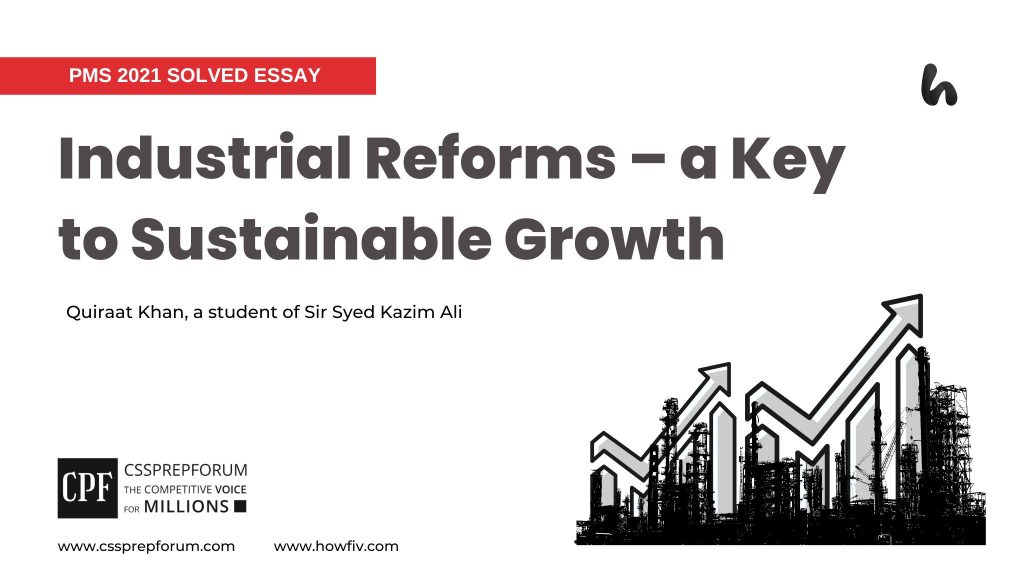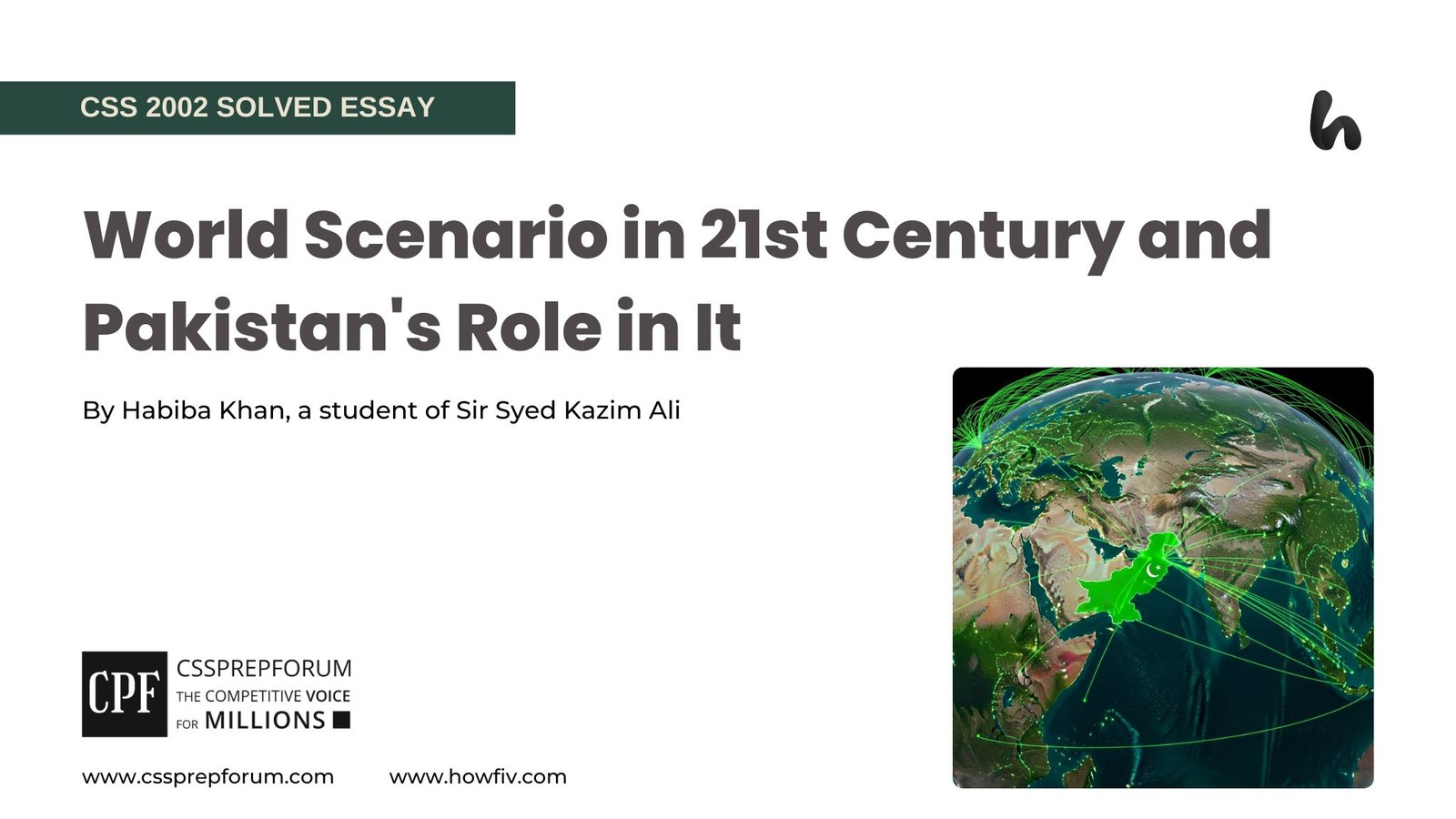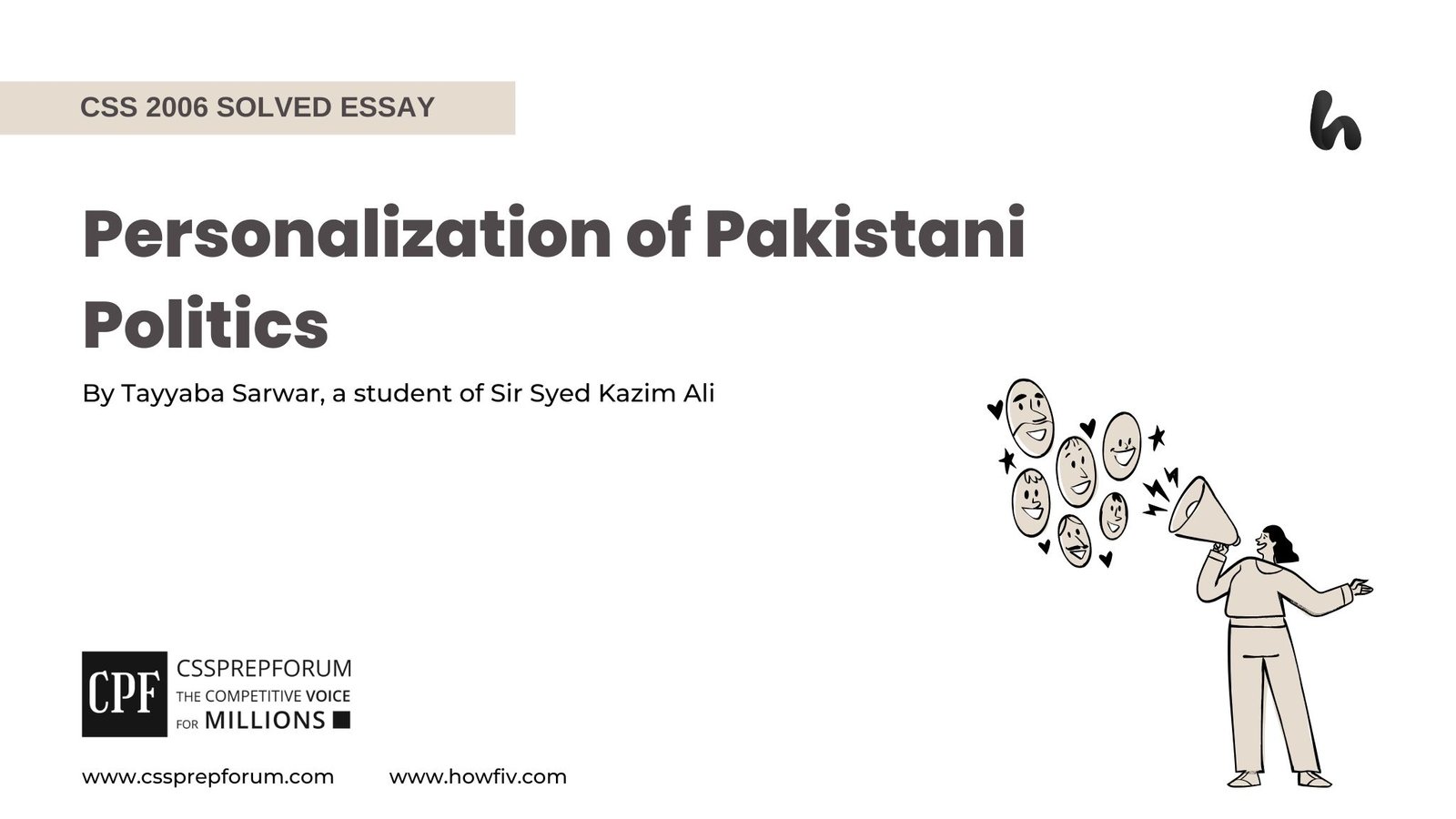PMS 2021 Solved Essay | Industrial Reforms – a Key to Sustainable Growth
Quiraat Khan, a Sir Syed Kazim Ali student, has attempted the PMS 2021 Solved Essay “Industrial Reforms – a Key to Sustainable Growth” on the given pattern, which Sir Syed Kazim Ali teaches his students. Sir Syed Kazim Ali has been Pakistan’s top English writing and CSS, PMS essay and precis coach with the highest success rate of his students. The essay is uploaded to help other competitive aspirants learn and practice essay writing techniques and patterns to qualify for the essay paper.

Outline
1-Introduction
Industrial reforms mould existing policies by evolving hurdles of industrial activity, such as free market inconsistencies, climate change, and social inequalities. Hence, many countries are opting for industrial reforms that facilitate the domestic market, ensure environmental regulation, and promote inclusive development, thereby leading them to sustainable growth.
2-Understanding industrial reforms.
3-Contemplating the factors of sustainable growth.
- Building resilient economy
- Protecting the environment
- Ensuring social security
4-How are industrial reforms a key to sustainable growth for countries?
4.1-Building resilient economy
- Encourages domestic market production.
- The Inflation Reduction Act of the US focused on facilitating domestic markets.
- Creates space for innovation and technological advancement.
- China’s innovation policies promoted the local aerospace industry in the country.
- Attracts foreign investment in the country.
- Foreign investment policies – policies to attract, anchor and upgrade FDI and to regulate it – are an important element of industrial policies. – World Investment Report 2018
4.2-Protecting the environment
- Monitors the climate impact of industrial pollution.
- The vast carbon market system of the EU is aiming to cut 62 per cent of carbon emissions by 2030.
- Ensuring the sustainable use of resources.
- The EU plan for a circular economy to reduce waste.
4.3-Ensuring social security
- Reducing income inequality
- Progressive taxes, particularly direct income taxes, are a key channel for governments to reduce inequality in the short run. – World Bank Poverty and Shared Prosperity Report
- Encourages gender equity.
- The Nordic model for Nordic countries makes them some of the most gender-equal markets in the world.
- Provides employment opportunities to the people.
- In 2003–05, Germany undertook extensive labour market reforms, which were followed by a large and persistent decline in unemployment. IMF working paper 2005
Case study
China achieved sustainable growth with industrial reforms.
6-How does the absence of industrial reforms lead towards unsustainable growth?
- Unchecked pollution infiltrates the environment.
- Brazil’s environmental pollution
- Increasing income inequalities.
- Bangladesh income disparities
- Inconsistent production
Case study
India is on the path of unsustainable growth due to the absence of industrial reforms.
7-Critical Analysis
8-Conclusion

The pursuit of growth and development has concentrated countries’ investment in industrialization. Since the First Industrial Revolution, countries have heavily invested in the formation and execution of policies that facilitate industrial activity, considering it as the bedrock for economic growth. Unfortunately, rapid and unchecked industrial activity has created economic, environmental, and social impediments. Hence, countries are adopting industrial reforms, which mould existing policies following evolving hurdles of industrial activity. The reforms facilitate domestic markets and ensure environmental regulation and inclusive development, leading countries to sustainable growth. For example, the United States has introduced the reform of the Inflation Reduction Act to promote domestic production. Moreover, China is enjoying sustainable growth in the developing world by integrating reforms that eliminate economic and environmental obstacles. On the other hand, the absence of industrial reforms allows the proliferation of unregulated industrial activity, such as free market inconsistencies, climate pollution, and social inequalities, which clearly sets the course for unsustainable growth. For instance, India’s rising economy suffers from extreme income disparities and environmental degradation due to poor attention paid to industrial reforms. Therefore, for sustainable growth, the need for industrial reforms is imminent. The essay further delves into how industrial reforms are a key to sustainable growth for countries.
To begin with, it is important to understand the dynamics of Industrial reforms. These are the set of reformative policies that aim to remove obstacles to economic growth and development. The quest for industrialization brought waves of free market economic systems with minimum government regulation. However, with time, the adverse impacts of the system became vivid. For example, the financial crash of 1939 severely exposed the poor sustainability viability of economies. Therefore, to limit the repercussions of the system, governments worldwide increasingly stressed the need for government regulation and intervention through industrial reforms. Hence, countries have been adopting various industrial reforms to ensure secure economic development. These reforms are directed at regulating employment, financial tools, and social security. Multiple reforms are formulated in accordance with the changing dynamics and needs of the countries, all aiming to minimize the negative impacts of industrialization to achieve sustainable growth.
Moving further, sustainable growth refers to the equitable consumption of available resources in such a manner that the resources can be replenished for future generations. As industrial activity utilizes ample amounts of financial, human, and environmental resources, it is imperative to ensure that the activity is conducted in a sustainable manner. Hence, the notion of sustainable growth has grave significance in the contemporary world, as evidenced by the emphasis on sustainable development goals. However, to achieve the aspirational goals, countries need to work on the factors of sustainable growth, which includes the building of a resilient economy, protection of the environment, and fostering of social security. The planning, development, and execution of these factors can be ensured through the formation of proper industrial reforms.
Among the key factors of sustainable growth, industrial reforms for building a resilient economy are vital. For this reason, facilitation for the domestic market is necessary. In contemporary times, the globalization of markets has created competitive environments for domestic markets. Therefore, there is a need to provide protection to these markets so that domestic industries can gain a competitive advantage. For instance, the United States of America has formed the policy of the Inflation Reduction Act that provides subsidies to electric motor vehicle manufacturers. By this policy, the country aims to reduce dependence on imported EVM and encourage domestic production. The policy is a government intervention to regulate the sustainable economic growth of American markets.
Further, industrial reforms also create space for innovation and technological advancement. These are integral factors to ensure sustainable growth, as Sustainable Development Goal 9 stresses the need to foster innovation. That is because technology not only encourages production in the industries but also provides effective means of achieving production targets. For example, China’s innovation policies promoted the local aerospace industry in the country, making it the third destination in the world after the US and Europe to excel in aircraft manufacturing. The expansion of the aerospace industry has strengthened China’s economic resilience. This proves that industrial reformation directed towards enhancing innovation can lead to sustainable growth.
Another part of industrial reforms for building a resilient economy also focuses on attracting foreign investment in a country. The FDI is responsible for bringing financial investment, technology transfers, and entrepreneurship ideas to a country. These are crucial needs for strengthening the economic wheel. According to the World Investment Report 2018, FDI is a principal element of industrial policies. Thus, industrial reforms that promote the creation of conducive environments to attract foreign investors must be formed. For example, the industrial reforms brought through the China-Pakistan Economic Corridor in Pakistan have raised the amount of foreign investment in the country. Therefore, industrial reforms that invite foreign investments and build a resilient economy for sustainable growth are also necessary.
Apart from investing to build a resilient economy, industrial reforms also ensure the protection of the environment, which is crucial for sustainable growth. SDG Goal 11 has emphasized the need for green industrial activity. As industries are primarily responsible for contributing to climate change, countries are using reforms to limit carbon emissions. For example, the European Union has introduced reforms to establish vast carbon markets that would cut 62 per cent of carbon emissions by 2030. These markets would reduce carbon footprint significantly and ensure the maintenance of a healthy environment. Thus, such industrial reforms that ensure the protection of the environment contribute to the sustainable growth of the economy.
Additionally, industrial reforms can also ensure the sustainable use of resources. As excessive production and consumption patterns have accelerated environmental pollution, policies that reduce this system can be made to tackle climate chaos. For example, the EU has incorporated a circular economy structure into the system. The reform of circular economy is a model of consumption and production involving cycles of leasing, reusing, repairing, refurbishing, and recycling existing materials and products. Thereby ensuring an equitable usage of available resources and reducing pollution. Such industrial reforms also encourage the sustainable growth of countries.
Achieving social security is also a key factor for sustainable growth, which can be achieved by tackling social crises. Among many social issues, income inequality is a stagnant problem, which has widened due to rapid industrialization and has been included in the SDGs. Fortunately, it can be tackled through industrial policy reforms. According to the World Bank Poverty and Shared Prosperity Report, progressive taxes, particularly direct income taxes, are a key channel for governments to reduce income inequality in the short run. Many Nordic countries have adopted progressive taxes to reduce income inequalities in the region and to promote sustainable growth. Thus, to achieve sustainable growth, industrial reforms that reduce income inequality are necessary.
Furthermore, gender inequality is also an entrenched social problem that has increased due to industrialization. Thus, industrial reforms that encourage inclusive development are needed for sustainable development. For instance, the Nordic model of industrial development for Nordic countries helps them to establish some of the most gender-equal markets in the world. The model encourages equal distribution of resources and opportunities to all genders. Thereby fulfilling one of the key SDGs. Therefore, the example establishes that industrial reforms are necessary for achieving gender equity and sustainable economic growth.
Besides ensuring inclusive growth, another social security dilemma that comprehends society is unemployment. Due to a lack of job opportunities, sustainable growth is massively impeded. Thus, reforms aiming to generate employment opportunities are needed. For example, in 2003–05, Germany undertook extensive labour market reforms, which were followed by a large and persistent decline in unemployment. Such industrially focused reforms can potentially increase job prospects. With a low unemployment rate, social security is ensured, and sustainable development is projected. Therefore, industrial reforms that create jobs are also necessary for sustainable growth.
Among the countries that formulate industrial reforms for sustainable growth, the most glaring example is China. The country has revitalized its economy, making it the second largest in the world through industrialization and openness. Additionally, the country also focuses on sustainable growth. For example, the broad objective of the twelfth five-year plan is to reorient growth to make it more balanced and sustainable. According to the UNDP, China has seen remarkable human development in recent years. Moreover, with its focus on industrial reforms and economic transformation, China has lifted 800 million people out of poverty. Further, the country is also investing in green environment policies to tackle climate change. According to Carbon Brief, China’s carbon emissions fell by 1.4 per cent in the first three months of 2022. These industrial reforms, which are paving the way for addressing the challenges to sustainable growth, are a clear representation of how industrial reforms are key to sustainable growth.
While industrial reforms regulate and check industrial activity, the absence of industrial reforms allows unsupervised industrial activity, which leads to unsustainable growth. To elaborate, unregulated industrialization creates massive pollution in the environment, which is a serious obstacle to sustainable development. For example, although Brazil is a shining example of economic growth, unfortunately, limited attention to environmental reforms and unchecked industrial activity has left Brazil’s biodiversity vulnerable. Forest fires in the Amazon rainforest have become common. These are grave repercussions of the absence of industrial reforms on the sustainable growth of the country.
Moreover, the proliferation of rapid industrial activity has also created income inequalities in many developing economies. For example, Bangladesh has become a centre for garment manufacturing and industrial production. However, it suffers from extreme income inequalities. Although there are as many as 4 million workers in the garment business, the average worker earns less in a month than a US worker earns in a day. The enormous difference is due to the negligence of the government to develop income policies by collaborating with the private sector. Income inequality is one of the core reasons for Bangladesh’s unsustainable growth. Thus, the example portrays the significance of having industrial reform policies for ensuring income equality and subsequent sustainability.
Among the countries that are on the road to unsustainable growth, India is a vivid example. Although the country is an emerging economy, unfortunately, limited industrial reforms have created extreme income disparities in the country. To elaborate, human development stands abysmal, as evidenced by the high population, and poverty is rampant in the country. According to Oxfam, the top 10 per cent of the Indian population controls 70 per cent of the wealth in the country. These disparities depict that no strategically focused growth efforts have been adopted. Furthermore, carbon emissions have made it the 8th most polluted country in the world. This shows that the abrupt patterns of economic growth witnessed in India have paid little heed to the factors of sustainable growth.
Critically, industrial reforms play an important role in the sustainable growth of countries as they ensure a check on industrial activity, which is the single most crucial factor for economic growth. However, as industrialization creates many social, environmental, and economic hurdles with the changing dynamics of the industry, it is necessary to ensure that reforms are planned and implemented in accordance with the changes so that the negative impacts of industrial production can be minimized. Moreover, the reforms are essential due to the need for sustainable growth and development, which has increasingly been emphasized in the Sustainable Development Goals. Industrialization stands at the centre of growth policies, and developing industrial reforms is necessary for sustainable development.
In a nutshell, industrial reforms are a key to sustainable growth because they mould existing policies of industrialization according to the shifting economic, social, and environmental needs. I the present time, the rapid consequences of the waves of industrialization have made the world concerned about sustainable growth. That is why it is imperative to transform policies by reforming them. Therefore, many countries are tackling the problems of industrial activity like free market inconsistencies, climate change, and social inequalities by forming industrial reforms that facilitate domestic markets, ensure environmental regulation, and inclusive development, thereby leading them to a path of sustainable growth. While industrial reforms pave the way for sustainability, their absence severely gives rise to unregulated economic and social activities, which harm the efforts of sustainability, proving that industrial reforms are a key to sustainable growth of the countries.

CSS Solved Past Papers’ Essays
Looking for the last ten years of CSS and PMS Solved Essays and want to know how Sir Kazim’s students write and score the highest marks in the essays’ papers? Then, click on the CSS Solved Essays to start reading them.
CSS Solved Essays
CSS Solved General Science & Ability Past Papers
Want to read the last ten years’ General Science & Ability Solved Past Papers to learn how to attempt them and to score high? Let’s click on the link below to read them all freely. All past papers have been solved by Miss Iqra Ali & Dr Nishat Baloch, Pakistan’s top CSS GSA coach having the highest score of their students. General Science & Ability Solved Past Papers












